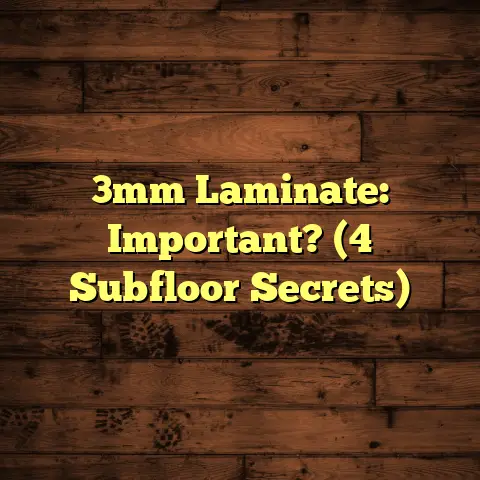Replace Laminate Planks? (4 Boards You CAN’T Fix!)
I’m Mike, and I’ve been laying down floors for over 15 years.
And let me tell you, I’ve seen it all – from minor scuffs to full-blown water damage disasters.
One thing I’ve noticed is a common misconception: that any damaged laminate can be fixed with a little DIY magic or by swapping out a plank or two.
Trust me, I wish it were always that simple!
I’ve seen folks try to patch up warped boards, only to find the problem gets worse and costs them even more in the long run.
Think of it like this: you wouldn’t put a band-aid on a broken leg, right?
Same goes for your laminate!
So, let’s dive in and talk about when you can save a plank, and when it’s time to face the music and replace it.
Section 1: Understanding Laminate Flooring
First, let’s get on the same page about what laminate flooring actually is.
It’s basically a multi-layered synthetic flooring product fused together through a lamination process.
Think of it like a super-durable photo.
You’ve got a high-resolution image of wood (or stone, or tile, you name it) printed on a decorative layer, then sealed under a clear, protective wear layer.
Underneath that, you’ll find a core board, usually made of high-density fiberboard (HDF) or medium-density fiberboard (MDF), which gives the plank its structure and stability.
Finally, there’s a backing layer to provide moisture resistance and balance.
Now, why do people love laminate?
Well, it’s affordable, looks great, and comes in a ton of styles. Plus, it’s pretty easy to install, even for DIYers.
But, like any flooring, laminate isn’t invincible.
Over time, you might run into issues like:
- Scratches
- Dents
- Water damage
- Warping
- Fading
And that brings us to the big question: when is it fixable, and when is it a goner?
Section 2: The Importance of Identifying Repairable vs. Non-Repairable Boards
Before you grab your toolbox or start Googling “laminate repair hacks,” it’s crucial to take a good, hard look at the damage.
I always tell my clients: assess, assess, assess!
A little scratch? Probably fixable with a touch-up kit.
But a swollen, buckling mess? That’s a different story.
Here’s what I consider when deciding whether a board can be saved:
- Extent of the Damage: Is it just a surface issue, or does it go deeper?
- Location: Is it in a high-traffic area where the repair will be constantly stressed?
- Type of Laminate: Some laminates are more durable and repair-friendly than others.
- Your Skill Level: Be honest! Are you comfortable tackling the repair yourself, or is it better left to a pro?
If the damage is minor and localized, and you’re confident in your DIY skills, then a repair might be the way to go.
But if the damage is extensive, structural, or affecting multiple boards, replacement is usually the best (and sometimes only) option.
Section 3: The 4 Boards You CAN’T Fix
Alright, let’s get down to the nitty-gritty.
These are the four types of laminate damage that, in my experience, are almost always beyond repair.
-
Severely Water-Damaged Boards
Water is laminate’s kryptonite.
While some laminates are water-resistant, they’re definitely not waterproof.
When water seeps into the core of the board, it can cause it to warp, swell, and buckle.
Signs of severe water damage include:
- Visible swelling or bulging of the board
- Discoloration or staining
- A spongy or soft feel when you press on it
- Separation of the layers
- Mold or mildew growth (yuck!)
I’ve seen water damage from all sorts of sources:
- Flooding (obviously)
- Leaky appliances (dishwashers, refrigerators, washing machines)
- Plumbing leaks (under sinks, behind toilets)
- Spills that weren’t cleaned up promptly
According to the EPA, even small leaks can lead to significant mold growth in as little as 24-48 hours, making the problem even worse. Source: EPA Mold Resources
Once the core of the laminate is compromised, it’s almost impossible to restore it to its original condition.
Trying to patch it up is like putting a bandage on a sinking ship – it might look okay for a little while, but the underlying problem is still there, and it will eventually lead to more damage.
-
Boards with Deep Scratches and Gouges
Laminate’s wear layer is designed to protect it from everyday wear and tear, but it’s not indestructible.
Superficial scratches can often be buffed out or concealed with a touch-up kit, but deep scratches and gouges are a different story.
Here’s why deep scratches are a problem:
- They expose the core of the board to moisture, which can lead to swelling and warping.
- They create a rough surface that’s difficult to clean and can trap dirt and debris.
- They’re just plain unsightly and can detract from the overall appearance of your floor.
I’m talking about scratches that go through the wear layer and into the decorative layer or even the core.
These can be caused by:
- Dragging heavy furniture
- Dropping sharp objects
- Pets with long claws
- Kids playing rough (we’ve all been there!)
I had a client once who tried to hide a deep gouge with wood filler, but it just ended up looking worse because the filler didn’t match the color and texture of the laminate.
Trust me, sometimes it’s better to just bite the bullet and replace the board.
-
Warped Boards from Improper Installation
Proper installation is key to the longevity of your laminate floor.
One of the biggest mistakes I see is not allowing the laminate to acclimate to the room’s temperature and humidity before installation.
Laminate expands and contracts with changes in temperature and humidity.
If you install it before it’s had a chance to adjust, it can warp and buckle as it expands later on.
Signs of warping include:
- Visible waves or humps in the floor
- Gaps between the boards
- A hollow sound when you walk on certain areas
Another common installation mistake is not leaving enough expansion gap around the perimeter of the room.
Laminate needs room to breathe!
If it’s squeezed too tightly against the walls, it will have nowhere to expand, and it will eventually warp.
According to the North American Laminate Flooring Association (NALFA), proper acclimation and expansion gaps are crucial for a successful laminate installation.
Source: NALFA Installation Guidelines
Unfortunately, once a board is warped due to improper installation, there’s not much you can do to fix it.
Trying to force it back into place can damage the locking mechanism and create even bigger problems.
-
Boards with Structural Damage
Structural damage refers to any damage that compromises the integrity of the core board.
This can include:
- Cracks
- Splits
- Breaks
- Delamination (separation of the layers)
Structural damage can be caused by:
- Heavy impacts (dropping something really heavy)
- Excessive weight (placing a very heavy object on a small area)
- Subfloor problems (uneven or unstable subfloor)
I once saw a client who had a crack running through the middle of a laminate plank because they had placed a heavy safe on top of it without properly distributing the weight.
Structural damage is not only unsightly, but it can also be a safety hazard.
A cracked or broken board can create a tripping hazard, and it can also weaken the surrounding boards.
Trying to repair structural damage is usually a waste of time and money.
The repair will likely be temporary, and the damage will eventually return.
Plus, you’re just masking the underlying problem, which could be a sign of a more serious issue with your subfloor.
Section 4: The Replacement Process
Okay, so you’ve determined that you have a board (or several) that needs to be replaced.
Don’t panic!
The replacement process is usually pretty straightforward, especially if you have some basic DIY skills.
Here’s a general outline of the steps involved:
-
Gather Your Tools and Materials:
- New laminate planks (matching the existing flooring)
- Pencil
- Measuring tape
- Utility knife
- Chisel
- Hammer
- Pull bar
- Tapping block
- Safety glasses
- Gloves
-
Remove the Damaged Plank:
This is the trickiest part, especially if you’re dealing with a click-lock system.
- Start by carefully scoring the damaged plank with a utility knife to prevent chipping.
- Use a chisel and hammer to gently break the plank into smaller pieces.
- Work your way around the edges, being careful not to damage the surrounding planks.
- Once the plank is broken into pieces, you can remove them one by one.
-
Prepare the Subfloor:
- Make sure the subfloor is clean, level, and dry.
- Remove any debris or adhesive residue.
- If the subfloor is uneven, you may need to use a leveling compound to smooth it out.
-
Install the New Plank:
- Carefully align the new plank with the surrounding planks.
- Use a tapping block and hammer to gently tap the plank into place.
- Make sure the locking mechanism is fully engaged.
- Use a pull bar to tighten any gaps.
-
Clean Up:
- Vacuum or sweep the area to remove any dust or debris.
- Inspect the new plank to make sure it’s properly installed.
Important Note: If you’re not comfortable with any of these steps, it’s always best to call in a professional.
I’ve seen too many DIY projects go wrong, resulting in even more damage and expense.
Section 5: Preventative Measures for Future Issues
Alright, you’ve replaced your damaged planks, and your floor is looking good again.
But how do you prevent future problems?
Here are some preventative measures that can help extend the life of your laminate flooring:
-
Use Doormats: Place doormats at all entrances to trap dirt and debris.
-
Use Furniture Pads: Protect your floors from scratches by using furniture pads under all heavy furniture.
-
Clean Up Spills Immediately: Don’t let spills sit on your laminate floor, as they can seep into the seams and cause damage.
-
Avoid Excessive Moisture: Don’t use excessive water when cleaning your laminate floor.
Use a damp mop or cloth instead of a soaking wet one.
-
Maintain a Consistent Temperature and Humidity: Avoid extreme temperature and humidity fluctuations, as these can cause laminate to expand and contract.
-
Consider a Dehumidifier: If you live in a humid climate, consider using a dehumidifier to keep the humidity level in your home within a comfortable range.
-
Regularly Inspect Your Floors: Keep an eye out for any signs of damage, such as scratches, dents, or warping.
Addressing problems early can prevent them from becoming more serious.
I had a client who religiously followed these preventative measures, and their laminate floor looked as good as new after 10 years!
It just goes to show that a little bit of care can go a long way.
Conclusion
So, there you have it!
While some laminate flooring issues can be resolved with minor repairs, others require immediate replacement.
Recognizing when to replace laminate planks is crucial for preserving the overall quality and longevity of your flooring.
Remember these four types of boards you can’t fix:
- Severely Water-Damaged Boards
- Boards with Deep Scratches and Gouges
- Warped Boards from Improper Installation
- Boards with Structural Damage
By understanding the limitations of laminate repair and taking preventative measures to protect your floors, you can keep your laminate looking its best for years to come.
And if you’re ever in doubt, don’t hesitate to call a professional!
That’s all for now. Happy flooring!





